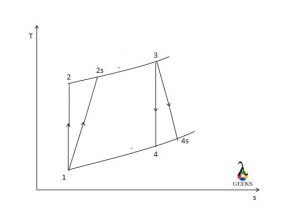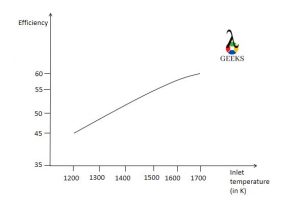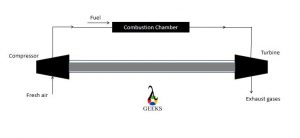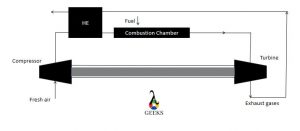- Gas turbine efficiency formula
- Gas turbine efficiency curve
- Hydrogen Gas turbine efficiency
- How to calculate gas turbine efficiency
- Open cycle gas turbine efficiency
- Practice questions
Gas turbine efficiency formula
Turbines are machines that harness kinetic energy of any fluid and help converting it to another form of energy (mostly electrical).
The turbines which use gas as working fluid are called as gas turbines. Gas turbines normally work on Brayton cycle to achieve desirable output.
For an ideal Brayton cycle (shown in figure below), efficiency is calculated as-

Where, h represents the enthalpy and subscript represents the state in the Brayton cycle.
Turbine efficiency is given by-
Where,
Subscript s denotes actual state.
Gas turbine efficiency curve
Gas turbine cycle efficiency rises exponentially till an optimum value of pressure ratio is reached, after that there is no significant change in the efficiency. The factors on which the efficiency of gas turbine depends are inlet temperature, pressure ratio and specific heat ratio of the working fluid.
Gas turbine efficiency curve on the other hand increases slowly. With higher inlet temperature, the efficiency of gas turbine increases. The graph below shows the relation between inlet temperature and turbine efficiency-

Hydrogen gas turbine efficiency
The need for Hydrogen turbine arises due to environmental concerns. Hydrogen as a fuel is very environment friendly. These turbines reduce CO2 emissions.
Hydrogen is mixed with the working fluid and this combination of Hydrogen-fuel mixture gives a better efficiency than using fuel alone. Using Hydrogen in large amounts is a problem because of its storage. Governments and private companies are working a way out for safer transport and storage of Hydrogen fuel.
How to calculate gas turbine efficiency
Mechanical losses lead to certain drop in performance of machines. According to second law of thermodynamics, no machine can give 100% efficiency.
The efficiency of gas turbines can be calculated using following steps-
- Calculate enthalpy at all points in the gas turbine cycle.
- Calculate actual work done by turbine using the formula-
Work done= h4-h3 - Calculate actual work done by turbine using the actual values of enthalpy after mechanical losses.
- Calculate efficiency using the relation–
Open cycle gas turbine efficiency
An open cycle is a cycle where the working fluid is not brought back to its initial conditions. Rather, it is discarded into sink. The efficiency formula of such cycles don’t change but the values change due to change in value of variables that is temperature and pressures.
An example of gas turbine open cycle is shown below-

Practice questions
What affects gas turbine efficiency?
Gas turbine efficiency depends mainly on three factors-
- Inlet Temperature-
Increasing the inlet temperature of the turbine increases its efficiency. Adding to which, decreasing sink temperature also increases the efficiency of gas turbines but it can be decreased upto ambient conditions only so it does not create much effect on efficiency. - Pressure ratio-
The pressure ratio P2/P1 is an important characteristic that affects the efficiency of gas turbine. - Specific heat ratio-
Specific heat ratio for ideal gases is around 1.4, real gases have values around 1.2-1.3. A good working fluid should have specific heat ratio value closer to isentropic value that is 1.4.
Why gas turbines have low efficiency?
Gas turbines work on constant volume cycles. As gases have lower density, they need extra work to be compressed hence increasing compressor work.
The formula for efficiency is given as efficiency = work done/heat added
As work done by compressor increases, the net work done decreases so the overall efficiency decreases. The efficiency of gas turbines can be increased by number of ways. Most common ways of improving efficiencies of gas turbines are regenerative cooling, intercooling, reheating.
How to increase efficiency of gas turbine?
There are number of ways by which the efficiency of a gas turbine can be increased. The factors that affect the efficiency directly are temperature, pressure ratio and specific ratio. Altering these values can directly affect the efficiency.
Hence, the ways that are proposed to increase efficiency include altering these values. Various methods used to increase the efficiency of gas turbines are-
- Regeneration-
In this method, exhaust gas is used to heat the working fluid at point 2. This results in decrease of exhaust gas temperature and increase in efficiency. The diagram of regenerative gas turbine cycle and efficiency formula is given below-

- Intercooling-
In this method, the compressor work is decreased by compressing the air in two stages. The air is cooled before going to the second compressor. This cooling of air between two stages is called intercooling. Decreasing the compressor work is directly associated with increase in efficiency. - Reheating-
In this method, two turbines are used instead of one. One turbine is used to produce work and other turbine drives the compressor. More heat is added in this process. Due to decrease in compressor work and high inlet temperature, efficiency increases. The diagram of reheat gas turbine cycle is shown below-

- Reheating, intercooling and regeneration combined-
In this method, all three methods are combined. The set up costs may soar up but overall efficiency increases by combining above three methods.
Combined gas turbine cycle efficiency
Combined gas turbine cycle uses multiple gas turbines working in tandem to provide more output.
The exhaust from single gas turbine cycle is still hot enough that it can run another cycle. Usually a heat exchanger is used between exhaust of first engine and inlet of second engine so as to use different working fluids. The output of second cycle is lesser than the first cycle but the overall efficiency of combined gas turbine cycle increases.
The first cycle is called as topping cycle and produces greater efficiency. The next cycle is called as bottoming cycle and may have different fuel (depending upon exhaust temperature of first cycle) and produces lesser efficiency than the first one. Overall the combined cycle can produce 50% more efficiency.
The formula to calculate overall efficiency of combined gas turbine cycle is given below
Hi ….I am Abhishek Khambhata, have pursued B. Tech in Mechanical Engineering. Throughout four years of my engineering, I have designed and flown unmanned aerial vehicles. My forte is fluid mechanics and thermal engineering. My fourth-year project was based on the performance enhancement of unmanned aerial vehicles using solar technology. I would like to connect with like-minded people.